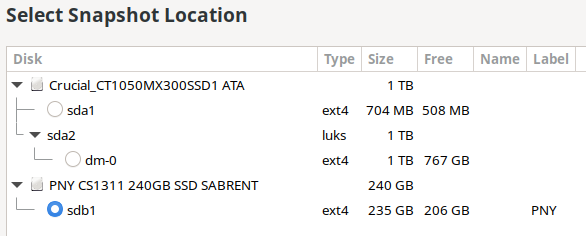I’m not sure what to select when I’m choosing the snap shot location on timeshift. I’ve always had set it up on dm-0, but I’m not sure if that’s the correct?
What’s the the difference between dm-0 and dm-1, and which one should I select?

I’m not sure what to select when I’m choosing the snap shot location on timeshift. I’ve always had set it up on dm-0, but I’m not sure if that’s the correct?
What’s the the difference between dm-0 and dm-1, and which one should I select?

You are being too vague, so my reply will be equally vague… The location to store your backups on must be the one that neither your system nor your /home is on.
There’s no point in making backups onto a drive that contains the very data that you’re backing up, because if that drive suffers a mechanical failure, you lose your backups just the same.
Aren’t Snapshots tied directly to the current installed system? By this I mean if I point Timeshift to My Files I to store the snapshots and for some reason I lose all data on my OS drive those snapshots are worthless to me, right?
Not if they are rsync snapshots.
The first backup of any given file — which can also mean “a file that gets added later on” — is a physical copy. If the file has not changed when the next snapshot is taken, then this next snapshot will link to the first copy. If however the file has changed, then it will be copied anew.
For instance, my system is installed on an SATA3-connected SSD, but I store my timeshift backups on a partition on an SATA2-connected HDD.
Of course, if we’re talking of btrfs snapshots, then that’s a whole other thing, because those are not backups. They are rollback/fallback snapshots, in which only the modified disk blocks are separate from the original content.
Unfortunately, a lot of people think that btrfs snapshots are backups.
@ Aragorn,
So just to be clear, I attach an external hard drive like the image below, and store it on that external hard drive. Also, the snapshot type is RSYNC. Is that correct?

To restore, I attach my external USB hard drive and restore it to which ever snapshot I chose. Is that correct?
Yes. ![]()
Yes. ![]()
Do you always use the RSYNC over BTRFS?
Also at what point do you want to use the BTRFS?
It might be a little smarter to prepare a separate timeshift partition on that drive and not to mix it with other data. If you backup once a week and regularly delete snapshots older than two months I guess you need much less than 206 GB for that partition.
btrfs is a filesystem type, and even though it offers the ability of having snapshots — which allows for an easy rollback — it offers many more advanced features which other filesystems don’t have, such as copy-on-write, checksums, self-healing, the ability to use subvolumes, and RAID 0, 1 and 10.
I actually do use btrfs on all of my filesystems except for /boot (which is ext4) and /boot/efi (which is vfat), albeit without subvolumes and without snapshots.
[nx-74205:/dev/pts/3][/home/aragorn]
[aragorn] > lsblk -o NAME,FSTYPE,MOUNTPOINT
NAME FSTYPE MOUNTPOINT
sda
├─sda1 vfat /boot/efi
├─sda2 ext4 /boot
├─sda3 btrfs /
├─sda4 btrfs /usr
├─sda5 btrfs /usr/local
├─sda6 btrfs /opt
├─sda7 btrfs
├─sda8 btrfs /srv
├─sda9 btrfs /home
├─sda10 swap
└─sda11 btrfs /var
sdb
├─sdb1 swap
└─sdb2 btrfs
sr0
Thanks a lot that clears things up. ![]()
One more issue that came up. How do I delete the old snapshot from the external SSD drive? Delete function won’t work on that.
Never mind, I figured it out. sudo rm-rf timeshift
It does normally work. For example… ![]()
sudo timeshift --delete --snapshot '2014-10-12_16-29-08'
See… ![]()
man timeshift
… or… ![]()
timeshift --help
OK that makes sense since I use BTRFS. As fior considering snapshots a backup even when I was using ext4 I always considered them snapshots only. Dead and useless if the main drive died. Thanks
This topic was automatically closed 2 days after the last reply. New replies are no longer allowed.